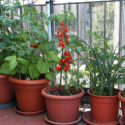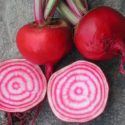The eggplant (Solanum melongena) is a vegetable of tropical origin. It is rather capricious and requires a lot of heat and sustained fertilization. However, those conditions can easily be obtained when growing eggplants in containers. In the spring, most Canadian garden centres offer eggplants in containers. Choose vigorous, compact plants that bear a few flowers only. As eggplants do not appreciate being transplanted, instead of buying plants in styrofoam flats, choose those that come in individual containers. However, if you wish to grow original eggplant cultivars, you will most likely have to buy seed.
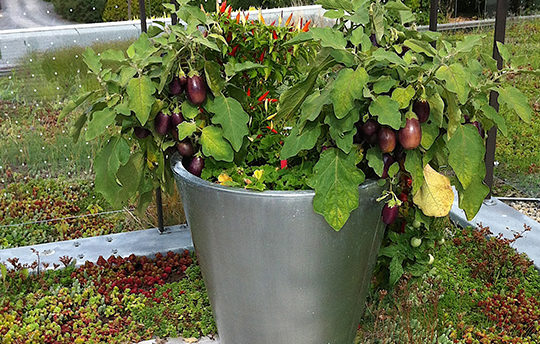
Eggplants have a good production when grown in dark metal or plastic pots, so the soil in which they are planted reach high temperatures. Eggplant seed must be seeded inside towards the very end of March or in April, i.e. about eight weeks before planting them in the garden. As mentioned earlier, eggplants do not like being transplanted, so it is preferable to place the seed in a container with multiple small cells filled with soil made up of equal parts of compost, peat moss and perlite, such as PRO-MIX Vegetable and Herb Mix. Seed two to three seeds per cell to make sure at least one plant will form. The seed must be placed at a depth of 6 mm (1/4 in). Then, water the soil generously with warm water. The optimal temperature for the germination of eggplant seed varies between 26 °C and 30 °C. To keep the growing medium warm, you can place the containers on a mattress or heating wires. Keep only one plant per cell by cutting the others with scissors. About three weeks after germination, when the first two true leaves are well formed, transplant the plants in 10-cm pots. Make sure a part of the stem (a few centimetres) is covered with soil. After the first transplantation, keep the temperature at 21 °C, day and night, until the plants are transplanted in the garden. Eggplants also need a lot of light to grow properly and develop. As light is generally rather poor in our homes, the seedlings must often be installed under an artificial lighting system which uses LED bulbs specifically designed for plants.
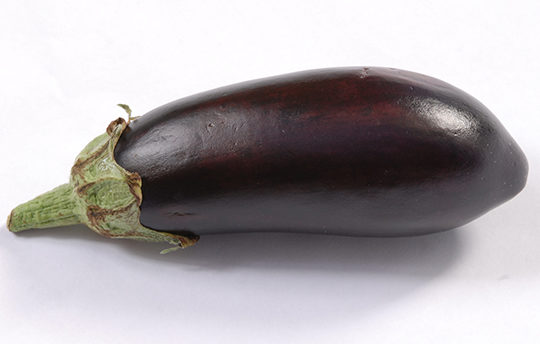
The ‘Morden Midget’ eggplant (Solanum melongena ‘Morden Midget’) works well for container growing. Eggplants are especially demanding plants. They must be planted in a place that is warm, very sunny and well protected from prevailing winds. However, by growing your eggplants in containers – in dark-coloured pots – against a south-facing wall, you will get very satisfying results. Eggplants prefer rich, loose soils that are well drained, and whose pH varies between 5.5 and 7. Exterior planting must be done one or two weeks after all risks of frost have been almost eliminated in your region. In zones 5 and 6, in Montréal and Toronto for example, eggplants are planted towards the end of May or in early June. Whether they were produced from seed or bought in a garden centre, do not forget to acclimatize your plants before planting them. Furthermore, add a slow release fertilizer to the soil– two to three handfuls per plant – whose formulation is about 4-6-8. Also, I recommend placing a black plastic film ou dark rubber mulch over the soil’s surface. This will increase the soil’s temperature and keep it between 27 °C and 32 °C. For small eggplant cultivars, such as “Morden Midget” or “Rosa Bianca”, use a container at least 40-45 cm in diameter for each plant. For bigger cultivars, choose bigger pots. Finally, as they appreciate stable moisture rates, you must water your eggplants on a regular basis. Water them with warm water twice a week, or three times a week in periods of extreme heat.
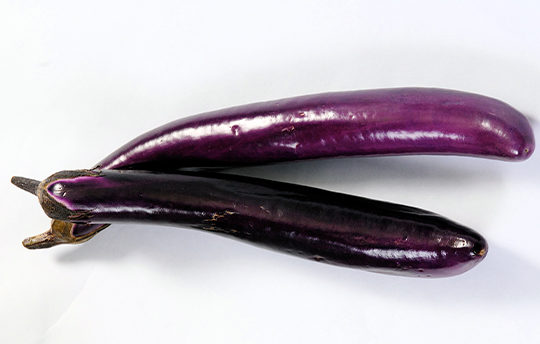
The ‘Pingtung Long’ eggplant (Solanum melongena ‘Pingtung Long’) is rather original!
